
National Institute for Basic Biology




| Organizers | Yoh Iwasa (Kyusyu Univ., Japan) Stuart Pimm (Duke Univ., USA) |
|---|---|
| Venue | Okazaki Conference Center, Okazaki, Japan |
| Date | Jan. 25-30, 2004 |
| Poster |
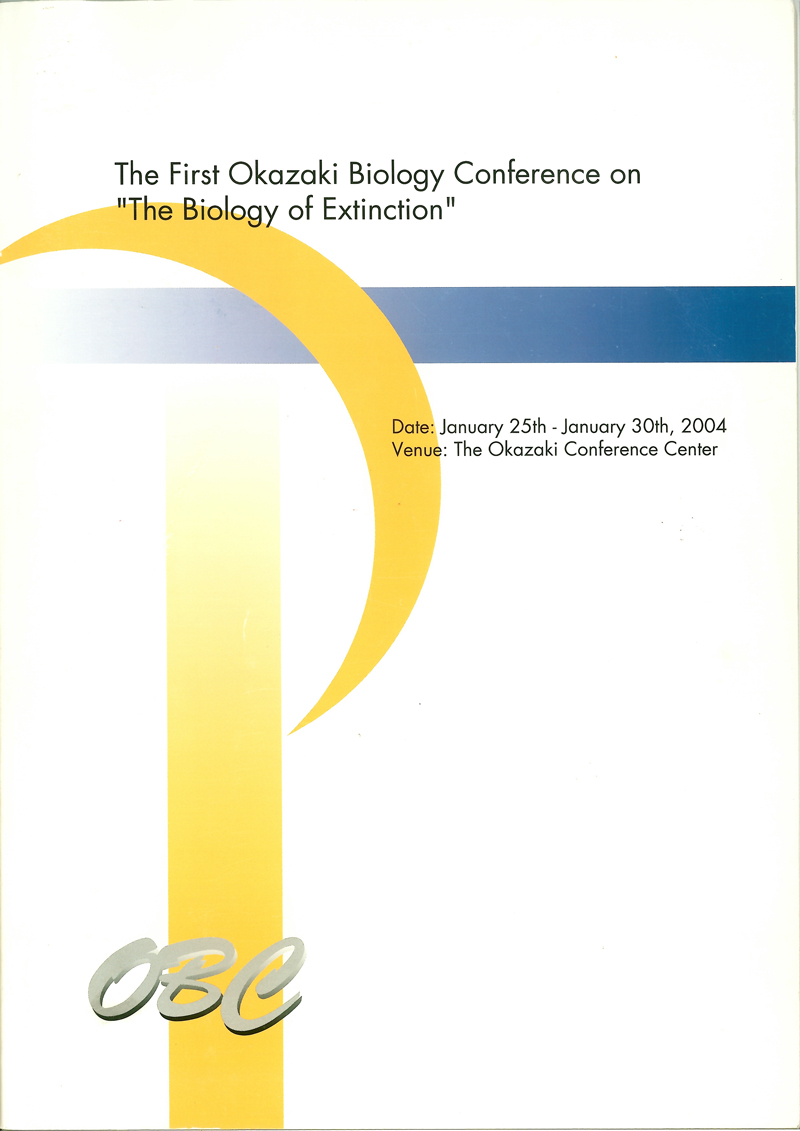
|
The purpose of the conference "The Biology of Extinction" was to discuss a wide range of aspects in biological sciences related to the extinction of species, and to explore the possibility of forming a new research field of basic biology centered around this theme.
On each day of the conference except for Wednesday, there were two oral sessions, one in the morning and another in the afternoon. These sessions constituted seven sets of papers with specific themes, each of which included three to five speakers. The contents of these oral sessions were as follows:
[1] Historic and prehistoric extinction.
[2] Phylogenetic approaches to extinction and the consequences of non-random species loss.
[3] Mechanisms of maintenance of production of species diversity.
[4] Populations and extinction risk. Extinction of a species started with the extinction of local populations.
[5] Mechanisms of population extinction- genetical approaches.
[6] Toward developmental biology of extinction: molecular biology of extinction enhanced by morphological specialization.
[7]Consequence of extinction.
The Wednesday morning was a time for poster presentations. In the Friday morning eight short talks were presented who were selected among 40 poster presenters, avoiding overlapping of the themes of these short talks with long talks. The quality of all of the posters and short talks were very high.
In summary, we believe that the meeting was successful one. This First OBC conference gave an opportunity for experts in different branches of biology and non-biology to meet.
The conference was about connections. There are connections between extinctions in the past and those in the future, connections between our knowledge of local populations in space and time and the general patterns of which species are most vulnerable to extinction. The hope of the conference was to bring together those who study extinctions and different spatial and temporal scales. We can provide many examples where, in doing that, the speakers had raised the possibility for new and exciting work.
After the Thursday's program, we elected Tetsukazu Yahara and Callum Roberts as two organizers of the succeeding conference. It is to be held in two years on the same topic.
Press Information
Nature
An editor, Dr. David Cyranoski, participated in the conference and wrote a short news article in the journal (Nature vol. 427 pp.477 "Extinction meeting kicks off Japan 's plans for networking" ( 5 February 2004 )).
Trends in Ecology and Evolution
The editor, Dr. Katrina A. Lythgoe, participated in the conference and commissioned several review articles from the conference, which will appear in the journal in 6 to 9 months.
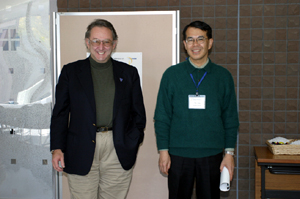
The organizers, Prof. Stuart Pimm (left) and Prof. Yoh Iwasa (right).
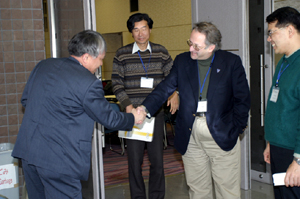
The organizers and Prof. Motoya Katsuki, Director General of NIBB.
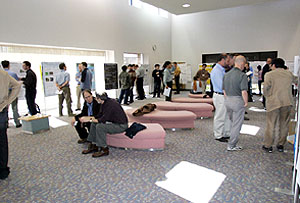
Forty poster presentations were given.
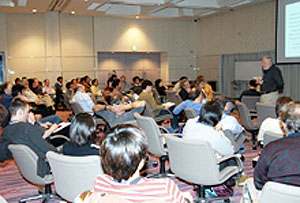
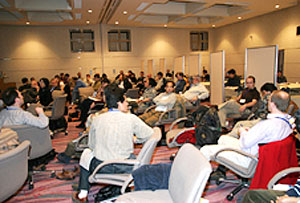
Eight sessions were held during 5-day conference period, which were filled with active presentations and discussions.
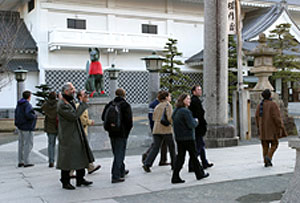
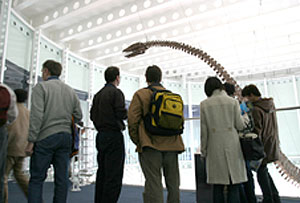
There was an excursion on the Wednesday afternoon to the Gamagori Natural History Museum and Toyokawa Shrine.
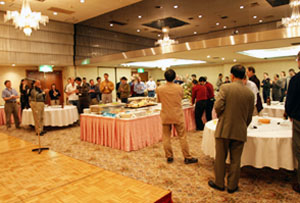
The conference dinner was held at the Okazaki New Grand Hotel.
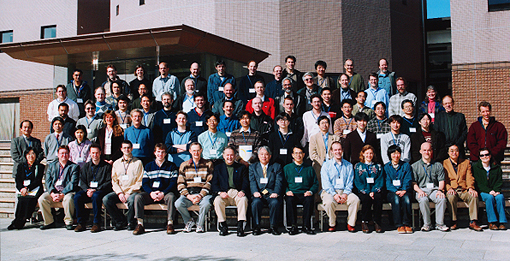
Participants of the conference.
January 25 (Sunday)
17:00-20:00
Get Together
January 26 (Monday)
08:30-09:20
Welcome Address and Introduction to Okazaki Biology Conferences
NAGAHAMA, Y. (Chair of OBC Committee, National Institute for Basic Biology (NIBB), Japan)
Introduction to “The Biology of Extinction”
IWASA, Y. (Organizer, Kyushu, Japan)
PIMM, S. (Organizer, Duke, USA)
Session 1 (Historic and Prehistoric extinctions)
09:20-12:10
“The timing and ongoing impact of megafaunal extinction in Australia”
FLANNERY, T. (Adelaide, Australia)
10:10-10:30
Coffee Break
“Caribbean Marine Extinctions on Different Time Scales: The Changing Roles of Geology, Climate, and People”
JACKSON, J. ( Scripps, USA )
“Extinction of genes, populations and fossil species”
CHIBA , S. ( Tohoku, Japan )
12:10-13:10
Lunch Time
Session 2 (Phylogenetic approaches to extinction and the consequences of non-random Species loss)
13:10-16:50
“Phylogenetic perspectives on the latest mass extinction”
NEE, S. ( Edinburgh, UK )
“Phylogenetic approaches to the study of extinction-recolonization dynamics”
SHAFFER, H.B. (UC Davis, USA )
14:50-15:10
Coffee Break
“Phylogenetic comparative studies of extinction risk in mammals”
PURVIS, A. ( Imperial College, UK )
“Ancient Radiation of African Cichlids? - Evidence from Retroposons”
TAKAHASHI, K. (NIBB, Japan )
17:30-19:30
Welcome Party
January 27 (Tuesday)
08:30-08:40
Announcement
Session 3 (Mechanisms of maintenance and production of species diversity)
08:40-11:30
“Modeling endemism, species richness and extinction on geographic scales”
COLWELL, R. ( Connecticut, USA )
“Contemporary global species Extinctions”
BROOKS, T. (Conservation International)
10:20-10:40
Coffee Break
“Community Canalization: One Reason Why Communities are Not Critical”
RUSSELL, G. ( Columbia, USA )
Session 4 (Populations and extinction risk)
11:30-17:00
“Dynamics of extinction in stochastic population models”
LANDE, R. (UC San Diego, USA )
12:20-13:20
Lunch Time
“Information transfer and extinction risk assessment of the endangered herb, Aster kantoensis”
SHIMADA, M. ( Tokyo, Japan )
“Reddening of Environmental Variability: Some Implications for Extinction Forecasts”
HALLEY, J.M. ( Aristotle, Greece )
15:00-15:20
Coffee Break
“Eroding viability of metapopulations in fragmented landscapes”
HANSKI, I. ( Helsinki, Finland )
“Spatial and temporal autocorrelation in extinction risk”
KUNIN, W. E. ( Leeds, UK )
January 28 (Wednesday)
08:30-08:40
Announcement
08:40-12:20
Poster session (Selected poster presenters will be requested to speak on Friday Morning)
PosterList.pdf
12:30-17:00
Excursion
January 29 (Thursday)
08:30-08:40
Announcement
Session 5 (Mechanisms of population extinction: genetical approaches)
08:40-11:30
“Genetics and extinction”
FRANKHAM, R. ( Macquarie, Australia )
“Toward predicting demographic and evolutionary fate of a population threatened: Primula Eco-Genome Project.”
WASHITANI, I. ( Tokyo, Japan )
10:20-10:40
Coffee Break
“Demographic and genetic consequences of forest fragmentation in the common understory berbaceous perennial Trillium camschatcense”
TOMIMATSU, H. ( Hokkaido, Japan )
Session 6 (Toward developmental biology of extinction: molecular biology of extinction enhanced by morphological specialization)
11:30-17:00
“Metamorphic timing in ambystomatid salamanders: Swimming the thin line between adaptation and extinction”
VOSS, S. ( Kentucky, USA )
12:20-13:20
Lunch Time
“Are cave animals an evolutionary dead end?”
WILKENS, H. ( Hamburg, Germany )
“Struggling with Red Queen: parasites, climatic changes, and human disturbance”
YAHARA, T. ( Kyushu, Japan )
15:00-15:20
Coffee Break
“Do Asexual Animals Face Evolutionary Dead Ends?”
VRIJENHOEK, RC. (Monterey Bay Aquarium Res. Inst., USA )
16:10-17:00
Panel discussion
lead by YAHARA, T. ( Kyushu, Japan )
17:00-17:15
Discussion
Discussion on Subsequent Conference of the Series
17:45-19:45
Dinner
January 30 (Friday)
08:30-08:40
Announcement
Session 7 (A session for short talks (8 talks), which will be selected among poster presenters)
08:40-12:20
4 talks
10:20-10:40
Coffee Break
4 talks
12:20-13:20
Lunch Time
Session 8 (Consequences of extinction)
13:20-15:00
“Living an increasingly unreliable world: The ecosystem consequences of biodiversity loss.”
NAEEM, S. ( Columbia, USA )
“Ecological Consequences of Global Warming: Past and Future”
ROOT, T. ( Stanford, USA )
15:00-15:20
Coffee Break
“Extinction risk and climate change”
THOMAS, C. ( Leeds, UK )
“The biology of extinction”
PIMM, S. ( Duke, USA )